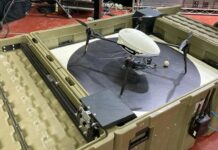The battlespace of today and tomorrow is undeniably defined by the proliferation of Uncrewed Aerial Vehicles (UAVs) and Uncrewed Ground Vehicles (UGVs). From frontline missions to intelligence gathering, accurate strikes, and supply delivery, these uncrewed systems play a key role in how modern militaries operate. Their effectiveness, however, hinges entirely on maintaining robust, secure Non-Line-of-Sight (NLOS) connectivity in contested environments.
While traditional military communication systems have long underpinned defense operations, the growing complexities of modern warfare are driving a pivotal shift to cellular communications, which are now emerging as a critical enabler for advanced UAV and UGV missions.
Prevailing military UxS communications may not be ready for tomorrow’s warfare demands
Military UAV/UGV operations have traditionally relied on several communication technologies, each with distinct advantages and limitations.
- Line-of-Sight (LOS) Radio Frequency (RF) links served as the foundational communication method for UxS, delivering direct, low-latency command and control (C2) and data transmission when the uncrewed vehicle is within the operator’s visual or RF line of sight. While simple and generally reliable for close-range operations and reconnaissance, the strict line-of-sight requirements expose personnel to increased risk and severely constrain operational reach and effectiveness in complex terrain, urban environments, and extended-range missions.
- Mesh radio, often enabled by Software-Defined Radios (SDRs), establishes ad hoc, self-forming, and self-healing multi-node networks linking UAVs, UGVs, and ground command elements. This architecture supports many-to-many communications, providing redundant pathways, extended range, and high resilience in dynamic operational environments, such as swarm formations or dispersed maneuver forces. SDR technology enhances adaptability, enabling dynamic frequency agility, modulation reconfiguration, and spectrum optimization to maintain mission-assured connectivity in the presence of sophisticated electronic warfare threats. While highly effective for localized and decentralized operations, these systems face scalability challenges across extended battlespace areas and demand substantial resources for design, deployment, and lifecycle maintenance.
- Proprietary military data links are purpose-built communication systems engineered to meet specific operational, security, and interoperability requirements. Many of these links are also built on SDR technology, but are locked to specific, certified waveforms and encryption protocols tailored to a defined mission set. These links are optimized for secure, point-to-point or point-to-multipoint communications between uncrewed platforms and designated command nodes, ensuring predictable performance, latency, and compliance with military interoperability standards. However, this closed architecture reduces agility, limiting adaptability to new platforms or mission sets and often requiring lengthy redesign and recertification cycles to counter emerging threats.
- Satellite communication (SATCOM) systems extend operational range significantly, allowing unmanned vehicles to operate in remote or austere environments where terrestrial infrastructure is absent. But they have their own set of challenges. SATCOM faces weather-based challenges affecting signal quality (rain, humidity, temperature extremes), requiring robust technical solutions and careful operational planning to meet its sky needs: clear LOS, high environmental resilience, and strategic deployment. Furthermore, SATCOM’s inherent latency and bandwidth limitations can degrade real-time control, especially during time-sensitive targeting or dynamic maneuvers.
While these foundational methods have served as the backbone of uncrewed operations, the emergent character of modern warfare – demanding a faster pace, greater agility, and increased autonomy– compels a fundamental re-evaluation of military communication paradigms.
Bridging uncrewed systems’ operational gaps: The cellular advantage
Cellular communication is no longer the domain of commercial applications alone. Militaries worldwide are recognizing the potential to augment existing infrastructure and close critical capability gaps. The advancements in 4G LTE and 5G directly address many of the inherent limitations in legacy military communication systems.
- Pervasive coverage and accessibility. The ubiquity of civilian cellular infrastructure provides extensive coverage, supporting uncrewed operations across diverse geographical regions and a vast array of environments. This pervasive footprint significantly reduces the logistical burden and time required for deployment, eliminating the need to establish a dedicated military communication infrastructure in many scenarios.
- Seamless BVLOS connectivity. Cellular communications enable beyond visual line-of-sight (BVLOS) connectivity in UxV (unmanned vehicles) missions by leveraging the existing cellular 4G LTE and 5G network infrastructure to maintain continuous, long-range communication between platforms and ground control or cloud systems. As cellular towers cover vast geographic regions, UxVs stay connected beyond the operator’s line of sight. Smooth handover support allows UxVs to move between cell towers while maintaining a persistent connection, crucial for long-range missions. Cellular networks support real-time telemetry, command & control (C2), and video streaming over long distances. The low latency of cellular comms, particularly 5G, allows for faster responsiveness in mission-critical or autonomous functions.
- Enhanced resiliency and redundancy. Modern cellular networks operate across multiple operators and frequency bands and utilize numerous cell towers, creating a robust communication environment that can maintain connectivity even when individual network components fail or are compromised.
- Rapid deployment and scalability. The ability to leverage existing cellular infrastructure accelerates UAV/UGV deployment and communication recovery. This rapid establishment of communications is essential for crisis response and rapidly evolving tactical scenarios. Furthermore, the inherent scalability of cellular networks supports the simultaneous operation of numerous uncrewed systems, enabling swarm tactics and large-scale ISR collection with unprecedented ease.
- High bandwidth and low latency. Contemporary cellular networks, notably 4G LTE and 5G, deliver higher bandwidth and significantly lower latency compared to traditional military SATCOM or many legacy data links. This enhanced bandwidth enables real-time transmission of high-definition video, rich sensor data, and critical telemetry, providing military forces with instantaneous data transfer for critical decision-making.
- Cost-effectiveness and SWaP optimization. Utilizing commercial cellular infrastructure offers a compelling economic advantage, significantly reducing both initial deployment costs and persistent operational expenses associated with tailored military communication networks. Furthermore, commercial-off-the-shelf (COTS) cellular modems are inherently Size, Weight, and Power (SWaP) optimized, a critical consideration for payload-constrained uncrewed platforms.
![[Copyright: Elsight]](https://euro-sd.com/wp-content/uploads/2025/08/Elsight-Spectrum-Illustration-.jpg)
Overcoming cellular communication challenges in UAV/UGV operations
Despite the clear advantages, implementing cellular communication in military UxV operations presents several challenges that must be carefully addressed.
Security concerns top the list, as commercial cellular networks were not designed with military-grade security requirements in mind. The solution lies in implementing a robust security overlay, military grade encryption , data-splitting across multiple communication channels and cellular networks, and secure VPN tunneling.
Cellular coverage, while extensive, can be inconsistent in truly remote, austere, or highly contested environments. A multilink, redundant communication architecture can bridge these gaps to ensure persistent connectivity when one or more links are degraded or denied. A multilink architecture utilizes an intelligent communication layer that seamlessly handoffs between multiple available links, such as cellular, SATCOM, or any proprietary military radio links, based on real-time network conditions.
Adversaries will invariably attempt to jam or intercept communication channels. Employing multilink architecture and data splitting across multiple networks makes it exponentially more difficult to jam all communication channels simultaneously.
The cellular impact: Shaping the future of military UxS operations
The adoption of commercial cellular technology in military uncrewed operations represents a fundamental doctrinal shift toward leveraging advanced commercial capabilities for military applications. This approach offers significant advantages in terms of technological agility and operational flexibility. Innovative communication solutions are already demonstrating that security and coverage challenges can be effectively addressed through multilink architectures, layered security approaches, and dynamic link management.
As technology continues to develop more rapidly than ever, cellular-enabled UAVs/UGVs will undoubtedly play an increasingly pivotal role in shaping the future of warfare. The ability to deploy commercially available off-the-shelf (COTS) communication capabilities without extensive capital and time investments provides military operations with enhanced operational flexibility, reduced logistical burden, and a distinct tactical advantage. The future of military uncrewed systems is inextricably linked to the pervasive and resilient power of cellular connectivity.
For more information, write info@elsight.com or visit www.elsight.com.
Author:
Yoav Amitai
CEO Elsight

Susan Becker
E: susan.b@elsight.com
T: +972-77-751-600
M: +972-50-4747895
Elsight Ltd.
3 Ariel Sharon Blvd.
Or-Yehuda 6037606, Israel
You can find more Case studies here.
Find out more here: www.elsight.com




![Elsight Article Image Is Cellular Connectivity the key to UAV.. Is Cellular Connectivity the Key to UAV and UGV Battlefield Dominance? By Yoav Amitai, CEO, [Copyright: Elsight]](https://euro-sd.com/wp-content/uploads/2025/08/Elsight-Article-Image-Is-Cellular-Connectivity-the-key-to-UAV.jpg)



![Are you deceiving me? A dummy Sherman tank, of the type used by FUSAG. [US National Archives]](https://euro-sd.com/wp-content/uploads/2025/05/Dummy-Sherman-tank_US-National-Archives-Kopie-218x150.jpg)





